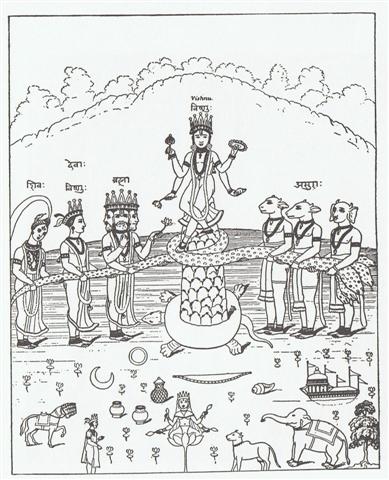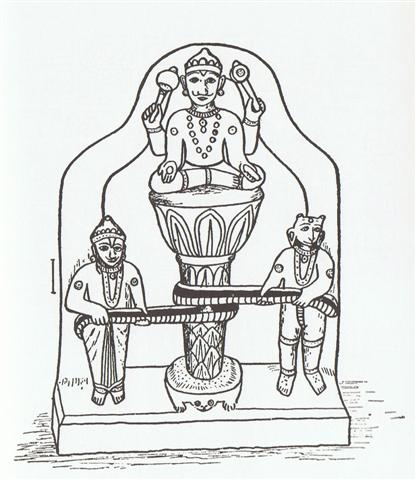Since the time of the Babylonians the constellations had moved ahead in the year, with the C text therefore beginning with the thirsty Raven at the September equinox:
... Midsummer is the flowering season of the oak, which is the tree of endurance and triumph, and like the ash is said to 'court the lightning flash'. Its roots are believed to extend as deep underground as its branches rise in the air - Virgil mentions this - which makes it emblematic of a god whose law runs both in Heaven and in the Underworld ... The month, which takes its name from Juppiter the oak-god, begins on June 10th and ends of July 7th. Midway comes St. John's Day, June 24th, the day on which the oak-king was sacrificially burned alive. The Celtic year was divided into two halves with the second half beginning in July, apparently after a seven-day wake, or funeral feast, in the oak-king's honour ... Whereas at the time of Haedus II the Raven had been precisely beyond the Midsummer Tree, where the 2nd half of the year was beginning and when the Sun had been at Crux.
The other girl, Crow, had then gone far away (in timespace) to fetch true sweet water - apparently to the spring equinox at the time of Hyadum II (11 precessional days later than Haedus II):
Raven and Crow were no longer close together. But the distance from one sister to the other was not 145 + 365 - 265 = 245 days but rather 188 (●JULY 7) - 81 (MARCH 22) = 107. ... Space and time are a single, related concept in Runasimi [the language of the Inca people], represented by one word, pacha, which can also mean 'world' and 'universe'. The image of time familiar to Waman Puma was static and spatial: one could travel in time as one travels over earth - the structure, the geography, remaining unchanged. To him it does not matter that he shows Inka Wayna Qhapaq, who died in 1525, talking to Spaniards, who did not arrive until 1532. Wayna Qhapaq was the last Inca to rule an undivided empire: he is therefore the archetype, and it must be he who asks the Spaniards: 'Do you eat gold?' Although other people than the Chinese may have counted with Crow at Hyadum II instead of at the Eye of the Bull. ... It is known that in the final battle of the gods, the massed legions on the side of 'order' are the dead warriors, the 'Einherier' who once fell in combat on earth and who have been transferred by the Valkyries to reside with Odin in Valhalla - a theme much rehearsed in heroic poetry. On the last day, they issue forth to battle in martial array. Says Grimnismal (23): 'Five hundred gates and forty more - are in the mighty building of Walhalla - eight hundred 'Einherier' come out of each one gate - on the time they go out on defence against the Wolf.' That makes 432,000 in all, a number of significance from of old. This number must have had a very ancient meaning, for it is also the number of syllables in the Rigveda. But it goes back to the basic figure 10,800, the number of stanzas in the Rigveda (40 syllables to a stanza) which, together with 108, occurs insistently in Indian tradition, 10,800 is also the number which has been given by Heraclitus for the duration of the Aiōn, according to Censorinus (De die natali, 18), whereas Berossos made the Babylonian Great Year to last 432,000 years. Again, 10,800 is the number of bricks of the Indian fire-altar (Agnicayana).32 32 See J. Filliozat, 'L'Indie et les échanges scientifiques dans l'antiquité', Cahiers d'histoire mondiale 1 (1953), pp. 358f. 'To quibble away such a coincidence', remarks Schröder, 'or to ascribe it to chance, is in my opinion to drive skepticism beyond its limits.'33 33 F. R. Schröder, Altgermanischer Kulturprobleme (1929), pp. 80f. Shall one add Angkor to the list? It has five gates, and to each of them leads a road, bridging over that water ditch which surrounds the whole place. Each of these roads is bordered by a row of huge stone figures, 108 per avenue, 54 on each side, altogether 540 statues of Deva and Asura, and each row carries a huge Naga serpent with nine heads. Only, they do not 'carry' that serpent, they are shown to 'pull' it, which indicates that these 540 statues are churning the Milky Ocean, represented (poorly, indeed) by the water ditch,34 using Mount Mandara as a churning staff, and Vasuki, the prince of the Nagas, as their drilling rope. 34 R. von Heine-Geldern, 'Weltbild und Bauform in Südostasien', in Wiener Beiträge zur Kunst- und Kulturgeschichte 4 (1910), p. 15. (Just to prevent misunderstanding: Vasuki had been asked before, and had agreeably consented, and so had Vishnu's tortoise avatar, who was going to serve as the fixed base for that 'incomparably mighty churn', and even the Milky Ocean itself had made it clear that it was willing to be churned.)
The 'incomparably mighty churn' of the Sea of Milk, as described in the Mahabharata and Ramayana. The heads of the deities on the right are the Asura, with unmistakable 'Typhonian' characteristics. They stand for the same power as the Titans, the Turanians, and the people of Untamo, is short, the 'family' of the bad uncle, among whom Seth is the oldest representative, pitted against Horus, the avenger of his father Osiris.
The simplified version of the Amritamanthana (or Churning of the Milky Ocean) still shows Mount Mandara used as a pivot or churning stick, resting on the tortoise. And here, also, the head on the right has 'Typhonian' features. The whole of Angkor thus turns out to be a colossal model set up for 'alternative motion' with true Hindu fantasy and incongruousness to counter the idea of a continuous one-way Precession from west to east ... |
|||||||||||||||||||||||||||||||||||||||||||||||||||||||||||||||||||||||||||||||||||||||||||||||||||||||||||||||||||||||||||||||||||||||







